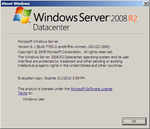Windows Server 2012 build 7700
| Build of Windows Server 2012 | |
 | |
| OS family | Windows NT |
|---|---|
| Version number | 6.1 |
| Build number | 7700 |
| Build revision | 0 |
| Architecture | x64 |
| Build lab | winmain |
| Compiled on | 2010-01-22 |
| Expiration date | |
| Timebomb | 2010-03-01 (+38 days) |
| SKUs | |
| Standard Server (Core) Enterprise Server (Core) Datacenter Server (Core) Web Server (Core) | |
| Product key | |
| Use Windows Server 2008 R2 Retail key | |
| About dialog | |
Windows Server 2012 build 7700 is the earliest available build of Windows Server 2012, which was jointly shared by community members lucasm and Wheatley on 25 December 2019. Prior to its public availability, screenshots of this build were released by Russian Windows news website WZor on 29 January 2010.
It has been determined to be a Windows Server 2012 build due to varying factors such as its relatively high build number, the presence of an early in-development version of Internet Explorer 9 and several non-user-facing changes to the operating system, such as group policy management changes, internal refactors to existing Windows functionalities and changes to the way code generation is handled throughout the build process.
Due to its earliness, this build identifies itself as its predecessor in various areas and still bears the 6.1 kernel version.
New features and changes[edit | edit source]
Hardware compatibility[edit | edit source]
The Streaming SIMD Extensions (SSE) CPU instruction set is now required in order to run this build, dropping support for CPUs such as the Pentium II; although this is moot, as there are no AMD64 CPUs that lack support for the instruction set.
Boot Manager[edit | edit source]
This build's Boot Manager introduces the following internal changes:
- Improvements to serial boot debugging through the addition of a driver for the Maxim MAX311 series (MAX3110E/MAX3111E/MAX3100/MAX3222E) SPI UART.
LdrProcessRelocationBlockLongLonghandles several architecture-specific relocations: IA-64, ARMv7, Thumb, Thumb-2, and MIPS.- Attempting to load an ARM Thumb-2 executable under the wrong architecture will now return error code
STATUS_INVALID_IMAGE_WIN_32.
Storage Manager for SANs removal[edit | edit source]
The Storage Manager for Storage Area Networks (SANs) feature has been removed from the operating system; it is therefore no longer possible to manage logical unit numbers on substorage systems that make use of either a fiber channel or an iSCSI configuration.
Miscellaneous[edit | edit source]
- Compared to the previous known
winmainbuild 7229, this build reverts the default Desktop Experience branding wallpaper seen in the R2 RTM release back to the older variant introduced as part of late Windows Server 2008 development. The older Windows Server 2008 R2 release candidate EULA set is also retained from previous builds. - Assertion strings have been changed to hide the full object path. In addition, some executables are signed by Windows Main Build Lab Account (
wmbla) like later Windows Server 2012 builds, unlike the standard Microsoft Corporation signer during the development and release of Windows 7. Server builds belonging to thefbl_srvbranch would be compiled by the Windows Server Builds account (srvbld) in subsequent builds. - A Windows 8 family search filtering option (along with a filtering option for the Windows 8 operating system) has been added to the Local Group Policy Editor utility.
- Internal code refactors to the On-Screen Keyboard application, including the addition of a new
osksupport.dlllibrary. - Additional APIs were also added for Audio and Bluetooth services.
Bugs[edit | edit source]
Installation[edit | edit source]
It is not possible to upgrade to this build without modification due to setup being unable to copy files required for installation, because of a signature validation error (0x80070241 == HRESULT_FROM_WIN32(ERROR_INVALID_IMAGE_HASH)).
To upgrade to this build, replace imageres.dll in each index of install.wim with a copy from build 7788.
Internet Explorer[edit | edit source]
The early version of Internet Explorer 9 (still branded as Internet Explorer 8) found in this build is known to be highly unstable and will often instantaneously crash when switching to IE9 mode or loading a page containing HTML5 content.
HTML Help[edit | edit source]
Certain help content present in the build (such as the Windows Firewall with Advanced Security documentation) may be erroneously blocked by Internet Explorer's Enhanced Security Configuration protocols.
Gallery[edit | edit source]
Windows Setup[edit | edit source]
Command Prompt and Registry Editor
Interface[edit | edit source]
Aero theme with the Windows Server 2008 wallpaper












